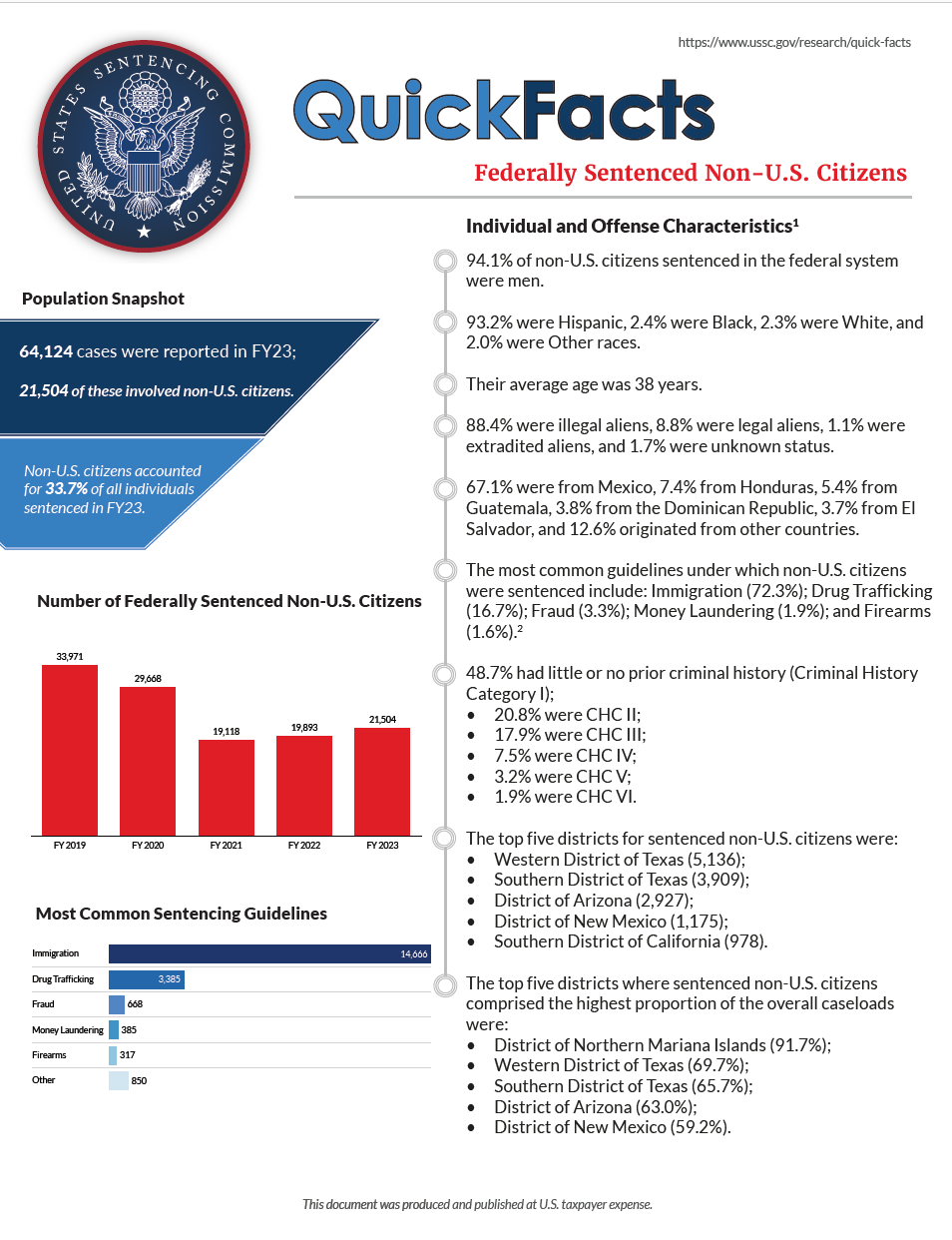Of the 61,678 cases reported to the Commission in fiscal year 2024, 21,304 involved non-U.S. citizens.1 Non-U.S. citizens accounted for 34.7% of all individuals sentenced in fiscal year 2024.
Click the cover for the PDF handout or learn more below.
Individual and Offense Characteristics
- 94.4% of non-U.S. citizens sentenced in the federal system were men.
- 93.7% were Hispanic, 2.3% were Black, 2.2% were White, and 1.8% were Other races.
- Their average age was 38 years.
- 88.7% were illegal aliens, 8.5% were legal aliens, 1.3% were extradited aliens, and 1.5% were unknown status.
- 65.9% were from Mexico, 8.7% from Honduras, 5.8% from Guatemala, 4.0% from the Dominican Republic, 3.0% from El Salvador, and 12.6% originated from other countries.
- The most common guidelines under which non-U.S. citizens were sentenced include: Immigration (72.3%); Drug Trafficking (17.6%); Fraud (3.1%); Money Laundering (1.8%); and Firearms (1.7%).2
- 52.7% had little or no prior criminal history (Criminal History Category I);
- 22.4% were CHC II;
- 15.2% were CHC III;
- 5.4% were CHC IV;
- 2.8% were CHC V;
- 1.5% were CHC VI.
- The top five districts for sentenced non-U.S. citizens were:
- Western District of Texas (5,610);
- Southern District of Texas (3,617);
- District of Arizona (2,340);
- District of New Mexico (1,111);
- Southern District of California (813).
- The top five districts where sentenced non-U.S. citizens comprised the highest proportion of the overall caseloads were:
- District of Northern Mariana Islands (84.6%);
- Western District of Texas (74.0%);
- District of New Mexico (66.2%);
- Southern District of Texas (64.1%);
- District of Arizona (63.0%).
Punishment
- The average sentence for non-U.S. citizens was 26 months.3
- 96.1% were sentenced to prison.
- 13.2% were convicted of an offense carrying a mandatory minimum penalty.
Sentences Relative to the Guideline Range
- 78.0% of sentences for non-U.S. citizens were under the Guidelines Manual.
- 56.0% were within the guideline range.
- 13.4% were Early Disposition Program (EDP) departures.4
- The average sentence reduction was 43.5%.
- The average sentence reduction was 43.5%.
- 4.7% were substantial assistance departures.
- The average sentence reduction was 51.4%.
- The average sentence reduction was 51.4%.
- 3.6% were some other downward departure.
- The average sentence reduction was 40.3%.
- The average sentence reduction was 40.3%.
- 0.3% were upward departures.
- The average sentence increase was 98.8%.
- The average sentence increase was 98.8%.
- 56.0% were within the guideline range.
- 22.0% of sentences for non-U.S. citizens were variances.
- 18.2% were downward variances.
- The average sentence reduction was 38.6%.
- The average sentence reduction was 38.6%.
- 3.8% were upward variances.
- The average sentence increase was 69.1%.
- 18.2% were downward variances.
- The average guideline minimum and the average sentence imposed have fluctuated over the past five years.
- The average guideline minimum was 22 months in fiscal year 2020 and 33 months in fiscal year 2024.
- The average sentence imposed was 17 months in fiscal year 2020 and 26 months in fiscal year 2024.
- The average guideline minimum was 22 months in fiscal year 2020 and 33 months in fiscal year 2024.
1 Cases with incomplete sentencing information were excluded from the analysis.
2 The most common guidelines under which U.S. citizens were sentenced include: Drug Trafficking (36.9%); Firearms (19.9%); Fraud (11.5%); Immigration (7.1%); Sexual Abuse (3.5%); Child Pornography (3.4%); and Robbery (3.2%).
3 The average sentence for U.S. citizens was 69 months.
4 “Early Disposition Program" (or EDP) departures are departures where the government sought a sentence below the guideline range because the defendant participated in the government’s Early Disposition Program, through which cases are resolved in an expedited manner. See USSG §5K3.1.
SOURCE: United States Sentencing Commission, FY 2020 through FY 2024 Datafiles, USSCFY20-USSCFY24.

